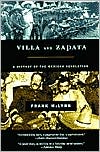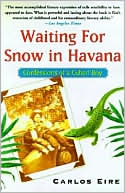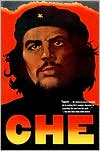Villa and Zapata: A History of the Mexican Revolution
Recounting the decade of bloody events that followed the eruption of the Mexican Revolution in 1910, Villa and Zapata explores the regional, international, cultural, racial, and economic strife that made the rebels Francisco (Pancho) Villa and Emiliano Zapata legends. Throughout this volume drama colludes with history, in a tale of two social outlaws who became legendary national heroes, yet—despite their triumph and only meeting, in 1914, in the Mexican capital—failed to make common cause...
Search in google:
Recounting the decade of bloody events that followed the eruption of the Mexican Revolution in 1910, Villa and Zapata explores the regional, international, cultural, racial, and economic strife that made the rebels Francisco (Pancho) Villa and Emiliano Zapata legends. Throughout this volume drama colludes with history, in a tale of two social outlaws who became legendary national heroes, yet—despite their triumph and only meeting, in 1914, in the Mexican capital—failed to make common cause and ultimately fell victim to intrigues more treacherous than their own. 16 pages of black-and-white photographs bring this gripping narrative to life. “McLynn ... tells it so well ... you can hear the strains of he Mexican patriotic standard ‘Zacatecas’ as you read it.”—Austin American-Statesman “An admirably clear account of the chaos of revolution, its rivalries and bloody struggles....”—The Spectator “Informative and insightful ... feels less like a history than a great story, as exciting as a Saturday serial Western.”—Publishers Weekly Publishers Weekly The Mexican Revolution began in 1910 and lasted for over a decade, a bloody and confusing saga of betrayal, corruption, misshapen politics and mislaid trusts that, in the end, accomplished little for lower- and lower-middle class Mexicans. Historian and biographer McLynn (Carl Gustav Jung; etc.) reconstructs the revolution through the biographies of its two most important figures, Francisco (Pancho) Villa, the bandit-turned-revolutionary, and Emiliano Zapata, whose declaration, "It's better to die on our feet than to live on our knees," later became La Pasionaria's Spanish Civil War slogan. Comprehensive almost to a fault, McLynn also devotes many pages to other key players: the revolution's first leader, Francisco Madero, who, having defeated President Porfirio D!az, stopped short of killing the president and members of the fallen government; and the ambitious Pascual Orozco, a controversial revolutionary figure believed by some (his pal Villa later among them) to have been on D!az's payroll. Having moved briskly and clearly through the disorganization and obfuscation of one of the bloodiest (and longest) revolutions in history, the author makes this informative, insightful study even more compelling with his witty and fluid prose. In his exhaustive research, McLynn plumbed "the ranks of the apocrypha," compared conservative histories to liberal ones and accounted for trends (economic, cultural, agricultural, industrial) concurrent with and pertinent to the revolution. McLynn grasps so completely and communicates so deftly the nuances of government corruption, the U.S. stance toward a long succession of Mexican autocrats, infighting between Zapatistas and Villistas, that this book feelsless like a history than a great story, as exciting as a Saturday serial Western. Three maps, 16 pages b&w photos. (Sept.) Copyright 2001 Cahners Business Information.
IllustrationsPrefaceThc Mexico of Porfirio Diaz1The Rise of Zapata33The Rise of Villa53The Rise of Madero72The Fall of Diaz88Madero and Zapata105Villa and Madero127The Revolt Against Huerta160Villa at his Zenith187The End of Huerta213The Convention of Aguascalientes244The Convergence of the Twain264Civil War286The Punitive Expedition313The Twilight of Zapatismo335The Decline of Villismo363Epilogue386Conclusion399Sources407Index441
\ Publishers WeeklyThe Mexican Revolution began in 1910 and lasted for over a decade, a bloody and confusing saga of betrayal, corruption, misshapen politics and mislaid trusts that, in the end, accomplished little for lower- and lower-middle class Mexicans. Historian and biographer McLynn (Carl Gustav Jung; etc.) reconstructs the revolution through the biographies of its two most important figures, Francisco (Pancho) Villa, the bandit-turned-revolutionary, and Emiliano Zapata, whose declaration, "It's better to die on our feet than to live on our knees," later became La Pasionaria's Spanish Civil War slogan. Comprehensive almost to a fault, McLynn also devotes many pages to other key players: the revolution's first leader, Francisco Madero, who, having defeated President Porfirio D!az, stopped short of killing the president and members of the fallen government; and the ambitious Pascual Orozco, a controversial revolutionary figure believed by some (his pal Villa later among them) to have been on D!az's payroll. Having moved briskly and clearly through the disorganization and obfuscation of one of the bloodiest (and longest) revolutions in history, the author makes this informative, insightful study even more compelling with his witty and fluid prose. In his exhaustive research, McLynn plumbed "the ranks of the apocrypha," compared conservative histories to liberal ones and accounted for trends (economic, cultural, agricultural, industrial) concurrent with and pertinent to the revolution. McLynn grasps so completely and communicates so deftly the nuances of government corruption, the U.S. stance toward a long succession of Mexican autocrats, infighting between Zapatistas and Villistas, that this book feelsless like a history than a great story, as exciting as a Saturday serial Western. Three maps, 16 pages b&w photos. (Sept.) Copyright 2001 Cahners Business Information.\ \ \ \ \ Library JournalIn a rare accomplishment, McLynn, a biographer of Sir Richard Burton, Carl Jung, and Napoleon, here presents his topic in a logical and understandable manner for almost every level of reader while also incorporating the latest research. While claiming to be writing a dual biography of Mexican rebel-outlaws Francisco (Pancho) Villa and Emiliano Zapata, McLynn has actually produced a judicious analytical account of the Mexican Revolution of 1910-20. He discusses the roles of the U.S. government, Gen. John J. Pershing's troops, German secret agents, and corrupt Mexican officials, drawing on a wide reading of English and Spanish studies and document collections. At the same time, his narrative is lively and gripping, leading the reader into this thoughtful study. Students and instructors of Mexican history at all levels will find the bibliographical essay invaluable. This belongs in all libraries whose patrons have even the most casual interest in Mexican history. Stephen H. Peters, Northern Michigan Univ. Lib., Marquette Copyright 2001 Cahners Business Information.\ \ \ Kirkus ReviewsVilla rides again, but this horse limps. At the outset, heavily published pop biographer McLynn (Carl Gustav Jung, 1997, etc.) points to three books that he calls a "lodestar" in studying the lives of Mexican revolutionaries Pancho Villa and Emiliano Zapata: Alan Knight's two-volume Mexican Revolution, John Womack's Zapata and the Mexican Revolution, and Friedrich Katz's recently published Life and Times of Pancho Villa. He is right to rely on those books, which historians regard as standard texts. Sadly, he hasn't done much with this densely written tome to match their accomplishments, except, as an English writer, to add some side notes on Winston Churchill's curious involvement in the internal affairs of faraway Mexico. (Churchill had his reasons: after all, McLynn notes, the British held 55 percent of all foreign investments in Latin America, and 29 percent of foreign investments in Mexico.) As befits a student of Carl Jung and Sigmund Freud, McLynn has a tendency to psychologize when writing about the likes of Porfirio Diaz and Francisco Madero, who, admittedly, had their issues. He captures well the infighting, personal as much as political in nature, which complicated the Mexican Revolution, as well as the international intrigues surrounding a decade of civil war. But while he gives a serviceable account of the lives of Villa and Zapata, among other revolutionary leaders, McLynn omits several important players and factions in the Revolution, makes frequent misstatements of fact (McLynn: "Like the Plains Indians of North America, the Mexican Indians never made common cause against their white rulers," and he's wrong about both), and offers dubious interpretations ofthe historical record. All in all, an amateurish entry in a literature already dominated by outstanding professional work.\ \







